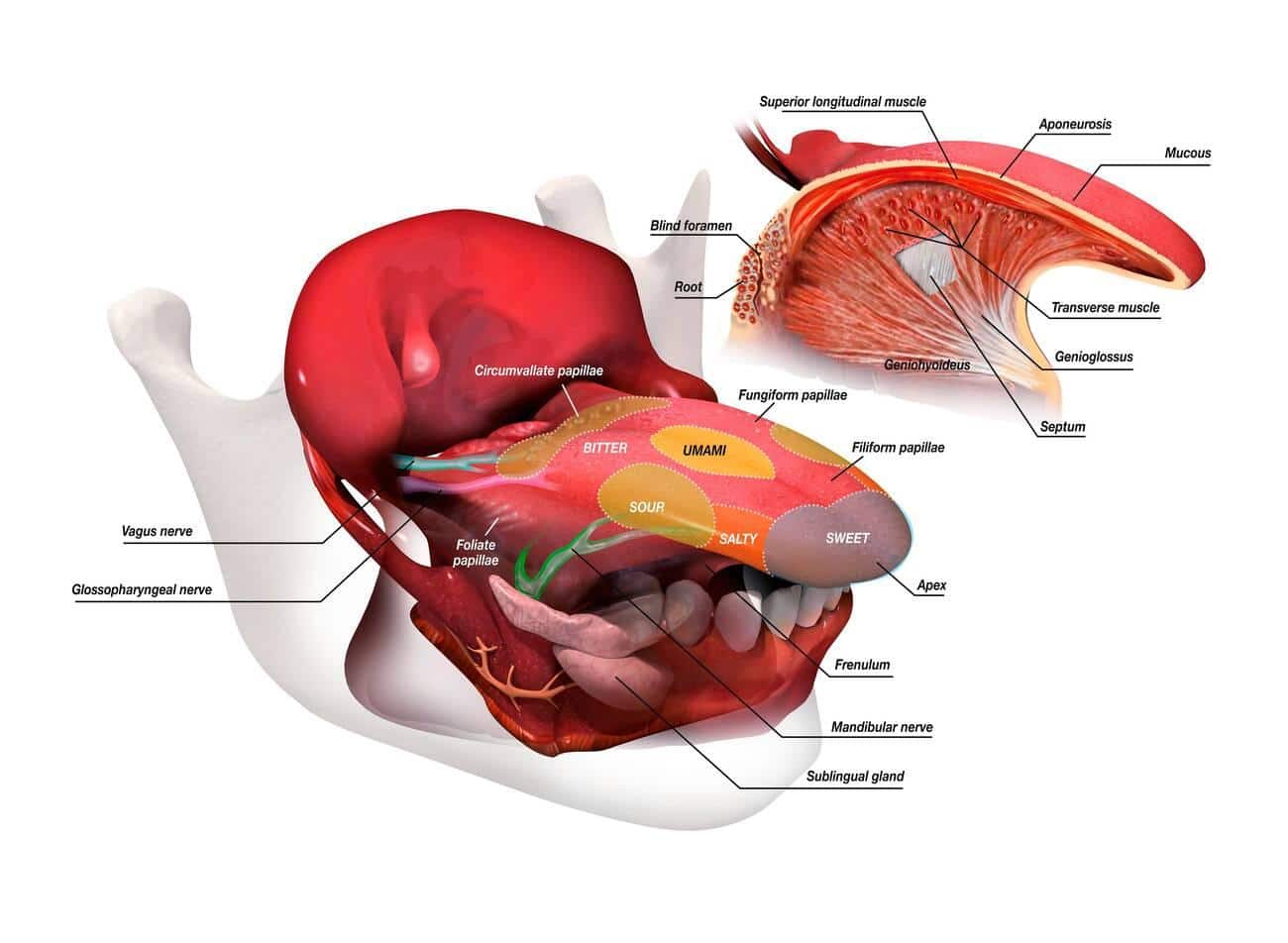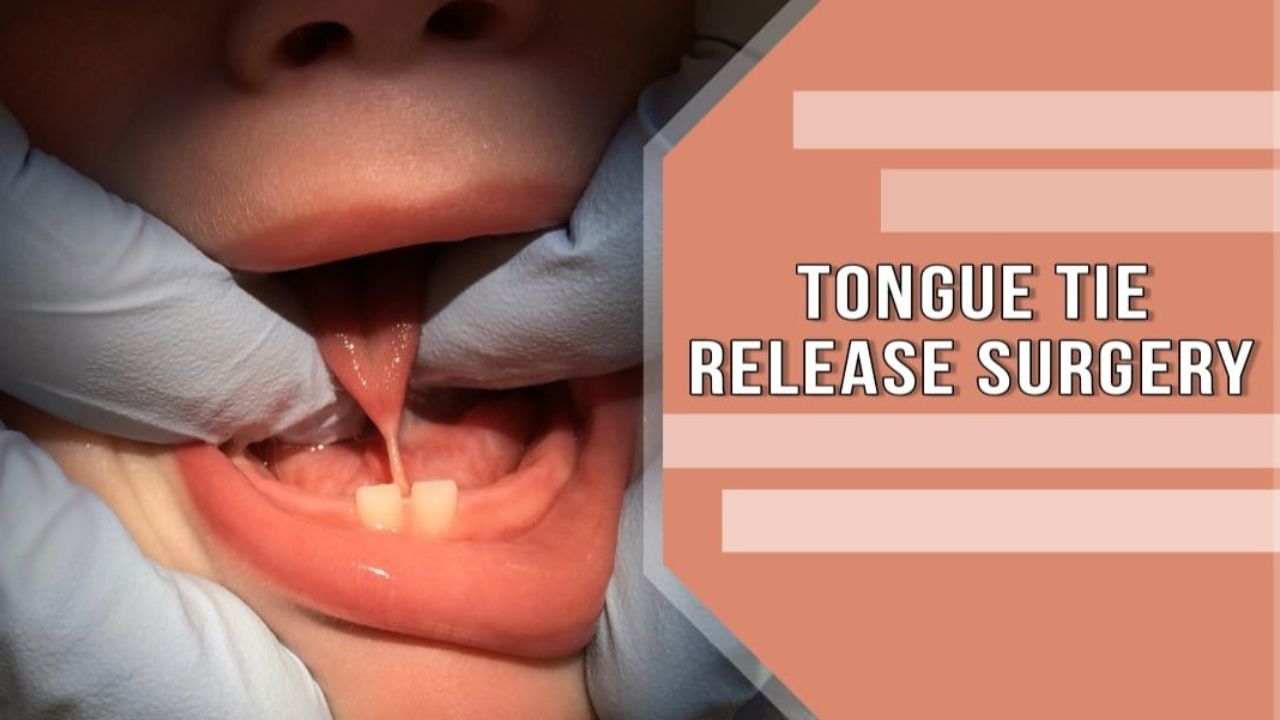Are you facing difficulty while breastfeeding your baby? Is your infant struggling to articulate words properly? This article will dive into the details of a tongue tie release surgery called a frenectomy.
A frenum is a connective tissue in the mouth that can limit the range of motion or cause gaps between teeth, and a frenectomy may be necessary to address these issues. Learn all about the procedure, including preparation steps, benefits, side effects, and recovery time, so you can decide whether this treatment is right for you.
Keep reading to get a complete insight into Frenectomy 101!
Content Highlights
- Frenectomy is a surgical procedure to remove the frenum, which connects different structures in the mouth, such as lips to gingival tissue or tongue to the floor of the mouth.
- There are two main types of frenectomy: Lingual and Labial. Both can help improve the breastfeeding experience for infants, the range of motion for tongues/lips, and speech articulation.
- Consider preparation for the procedure includes consulting with an experienced dentist or oral surgeon, followed by local anesthesia & sedation protocols depending on the individual case’s requirements, including any allergies present before proceeding.
- Follow aftercare instructions closely post-operatively to maintain optimum recovery levels while reducing risks significantly.
Understanding the Anatomy of the Mouth
There are two types of frenum in the mouth, a labial frenum and a lingual frenum, which connect different parts, such as the upper or lower lip to gingival tissue and the tongue to the floor of the mouth, respectively.

What is a frenum?
A frenum is a band of tissue or fibers that act as connections in the mouth. They attach to the lips, cheeks, and tongue to their respective adjacent structures. Most people’s mouths contain several essential frenums supporting oral health, such as increasing stability while chewing and speaking.
There are two common types of frenum found in the mouth: labial frenum, which attaches the inner surfaces of our lips to our gums, and lingual frenum, which connects the tongue to its base.
Other types include buccal mucosa attachments, which anchor cheeks firmly against teeth; alveolar ridges, which link the upper gum with the jawbone; and vestibular fold attachments located at either corner of your top lip, linking it securely with your face’s skin folds.
Types of frenum in the mouth
You have soft tissue and muscles, called frenums, in your mouth that help create tension in a person’s oral cavity. A frenum acts like an elastic band between two body points to form a bond by creating tension.
There are two main types of frenectomies: lingual frenectomy and labial frenectomy.
A lingual frenotomy involves restructuring the membrane (frenum) connecting the bottom of an individual’s tongue to the mouth floor or base of the lower jaw, also known as the mandible bone.
It works to loosen restrictions on movement caused by overly tight oral tissues, which can affect speech production and proper feeding techniques for infants when breastfeeding.
What is a Frenectomy?
[Video Credits @NYC Sleep Well]
A frenectomy is a surgical procedure in which the band of tissue (or frenum) that connects the lip, cheek, or tongue to the gums is removed.
Reasons for needing a frenectomy
Surgeons recommend frenectomy surgery if a patient has difficulty feeding, speaking, or oral health due to an overly tight frenum. A frenectomy aims to close the gap between teeth and correct conditions such as lip-tie, tongue-tie, diastema (the gap between teeth), gum recession due to overgrown tissue, or persistent pain during regular dental care.
A Frenectomy can help improve speech articulation by increasing the range of motion for the tongue. At the same time, infants who cannot breastfeed correctly may also benefit from this procedure.
Additionally, an adult’s gums could recede due to their lips or cheeks being too tightly anchored down near their lower front area, which usually requires a frenal attachment release called ‘frenotomy’ cases wherein it offers permanent results. In addition, you can also read an article on- What Causes Lip Tie in Adults?
Different types of frenectomy procedures
A frenectomy is a minor surgical procedure that involves the release or removal of tissue connecting the upper and lower jaw. This procedure is most commonly used to treat tongue-tie (ankyloglossia), where the frenulum connects the tongue’s underside to the mouth’s floor. Still, it may also involve other tissue connections in the mouth, such as those between gums and front teeth – known as labial frenum.
There are 2 types of frenectomy procedures.
- Lingual Frenectomy: It involves removing or modifying this tissue connecting under the tongue’s surface to the mouth’s floor to help prevent breastfeeding problems in newborns by providing more space for anterior movement and positioning bottle feeding or breastfeeding at times.
- Maxillary Frenectomy: It is a surgical procedure that involves removing or releasing the frenulum of the upper lip. The frenulum is the small band of tissue that connects the upper lip to the gum above the top front teeth.
Benefits of Frenectomy
A frenectomy procedure can offer multiple benefits to the patient, such as improved range of motion and speech clarity, enhanced breastfeeding experience for infants, and improved articulation.
Improved range of motion
Frenectomy surgery is a procedure to improve the range of motion of muscles and tissues in the mouth. It is especially beneficial when it comes to helping increase tongue movement, as many issues, such as tongue-tie, can limit the range of motion in this area.
The goal of frenectomy processes such as laser frenectomies is to cut or release rivers of tissue, called frena so that muscles can move more freely and without restriction. It significantly improves infant breastfeeding and increases speech clarity and articulation with improved tongue control.
An increased range of motion combined with therapy may correct speech difficulties caused by limited movement in adults, making it an essential procedure for children and adults alike.
Enhanced breastfeeding experience
A frenectomy is a surgical procedure that can help improve the tongue’s range of motion, making breastfeeding easier. With this improved range of motion, babies with tongue-tie can more easily maneuver their mouth for proper latches and suckle correctly.
It reduces mothers’ obstacles when breastfeeding and provides an enhanced nursing experience. A study found that tongue-tie release through frenectomy had a significant positive effect on improved sucking in breast-feeding children.
The Z-plasty and simple-release techniques showed more fabulous jaw-locking abilities than before surgery, allowing better milk extraction during breastfeeding sessions. Furthermore, parents reported greater satisfaction with their babies’ latching capabilities following the procedure due to improved mouth movement from findings associated with the Zplasty technique compared to the simple Release technique, according to recent studies.
Overall, It helps mothers ensure they have sufficient milk production so they can feed their baby without any challenges or discomfort while also providing an enjoyable bonding experience between mother and child during mealtime routines set up by both parties involved for extra happiness. Additionally, you can also read about- Lip Tie Surgery Details: A Quick and Easy Way to Improve Your Quality of Life
Improved speech and articulation
Frenectomy surgery is a procedure that involves the release of a tight frenum, which is a band of tissue located in the mouth. It can positively affect speech and articulation when used to treat issues caused by a tongue tie or lip tie.
In particular, the Z-plasty and simple-release techniques can improve the range of motion for improved articulation and sound production in some individuals.
Surgeons often perform the surgery on babies having difficulty breastfeeding due to an overly tight frenum, but it can also benefit adults with similar issues. They must consider this, especially when performing calving frenectomy surgeries, to ensure their safety and prevent complications such as bleeding or infection post-operatively.
Preparing for a Tongue Tie Release Surgery
Consult a specialist dentist or oral surgeon to properly assess the individual’s needs and understand what to expect before, during, and after a tongue tie release surgery or frenectomy procedure.
Consulting with a dentist or oral surgeon
When considering a frenectomy procedure to treat lip- or tongue-tie, it is crucial to consult a qualified dentist or oral surgeon. These experienced professionals can help assess whether the patient needs the surgery and advise on the most beneficial procedure.
They can also confidently explain the entire process from start to finish and answer any questions patients may have about the surgery beforehand and beyond the recovery period.
Additionally, dentists and surgeons are trained in local anesthesia and sedation protocols, ensuring a safe outcome for each case while considering any allergies or special considerations before proceeding with their recommendation.
What to expect during the procedure
During the frenectomy procedure, an oral health care provider first evaluates the patient to assess their overall health history and discuss any sedation or anesthesia options they may need.
Infants receive local anesthesia before removing the frenulum with scissors. Older children and adults can receive a local or general anesthetic during surgery.
After the operation is complete, doctors use numbing medication if necessary. Also, your healthcare provider may provide post-operative instructions such as managing pain or discomfort levels, counteracting swelling, proper hygiene protocols for healing, and follow-up visits for shaving off excess tissue in some cases.
Post-Operative Care
It is essential to adhere to a comprehensive post-operative care plan that includes pain and discomfort management, proper oral hygiene, and follow-up visits with the doctor.
Managing pain and discomfort
Pain and discomfort are common after frenectomy surgery. Your dentist or surgeon may prescribe medications such as ibuprofen, acetaminophen, and narcotics to combat them. Additionally, various techniques can make recovering from a frenectomy more comfortable.
Applying cold compresses to the area of operation helps minimize swelling and bruising while providing an anesthetic effect for pain relief. Local anesthesia—such as lidocaine gel—can also help manage pain at the incision site after surgery.
As always with medications, following instructions carefully to ensure safe use is essential.
Being mindful of oral hygiene is another essential part of post-operative care when undergoing a frenectomy procedure; antibacterial mouthwashes containing chlorhexidine can provide additional relief from discomfort while helping to reduce the risk of infection in the surgical area.
Proper rest and recovery time will also substantially promote healing; your doctor may recommend abstaining from physical activities like running or swimming until fully recovered.
Proper oral hygiene
The success of a frenectomy procedure and complete healing depend on how well the patient takes care of their mouth post-surgery. Patients should adhere to their dentist’s or surgeon’s instructions to prevent risks and complications.
It includes oral hygiene, such as gentle brushing, flossing, and rinsing with an antibacterial mouthwash daily. It is also important to avoid activities that put excessive pressure on the sides of the tongue, such as consuming hard foods or using a straw to drink liquids for some time after Surgery.
Proper oral hygiene also helps ensure that potential infections are detected and treated promptly, thus preventing further issues from happening in the long run. Strictly following these guidelines provided by your dental care provider will help reduce risk factors while promoting quicker recovery times so that patients can get back to regular activities without worry sooner rather than later.
Follow-up appointments
After a frenectomy, attending follow-up appointments with your dentist or oral surgeon is crucial. These postoperative visits help the doctor monitor your progress and are also essential to ensure that complications do not arise after the procedure.
Your dentist may give you specific instructions for at-home care, such as encouraging soft foods, avoiding sucking habits, and providing easy tips on reducing any potential pain from surgery.
Depending on the complexity of the procedure, more than one follow-up appointment may be necessary over weeks or months following surgery. Regular checkups allow dentists to spot any issues early to prevent them from becoming more severe problems later down the line.
Potential Complications
[Video Credits @Tongue Tie Galway]
Proper knowledge of the common risks and complications associated with tongue tie release surgery is essential before undergoing a procedure, so read on for more information.
Risk of infection
Frenectomy surgery is considered generally safe. However, there may be a small risk of infection in some cases. After the procedure, it’s important to take prescribed antibiotics and follow post-operative tips as directed by your healthcare provider to help prevent and reduce this risk.
Some dentists or oral surgeons will also recommend using an antibacterial mouthwash multiple times daily for at least two weeks after the surgery to reduce the chances of developing an infection.
Observations show that Infants recover quickly from frenectomies, which could indicate that they experience lower risks of infection than adults because their immune systems respond more effectively.
Laser frenectomy is also less invasive than traditional treatments, which can reduce any chances of complications due to infections caused by open wounds following the procedure. If you want you can also read- Top Healthcare Industry Trends for 2023
Bleeding and swelling
After a frenectomy procedure, it is normal for there to be some swelling and bleeding that typically lasts up to two weeks. Bleeding can also happen immediately after or during the surgery.
The amount of irritation and discomfort depends on the severity of the tongue tie, which will dictate how much tissue removal is necessary during the procedure. Swelling may cause pain, but this should lessen with time if you follow proper post-operative care steps, such as using ice packs or applying cold compresses (if your surgeon approves).
As for bleeding, any significant amount or prolonged bleeding is not average and should be brought to healthcare professionals‘ attention immediately. To reduce infection risk, try rinsing gently with salt water several times daily, taking anti-inflammatory medications if advised by a doctor, applying gauze soaked in the antiseptic wash until healed over completely, and eating soft foods like yogurt for at least one week following surgery.
Special considerations for children
You must consider special needs for children when it comes to frenectomy. One of the most important considerations is their age and development stage. While a frenectomy may benefit an adult with tongue ties, such as improved speech or dental issues, the same procedure can have more far-reaching impacts on a child’s future oral development.
It means specific procedures are employed when performing a frenectomy suitable for young patients to ensure their ongoing health and wellness.
In addition, infants may not always receive sedation due to safety concerns; newborns sometimes only receive proper medication after careful consideration from medical professionals.
Since breastfeeding and speech development are influenced mainly by tongue-tie in younger age groups (up to 4 years old), early detection allows for measures designed to stimulate postoperative recovery without lasting adverse effects on development milestones.
Additionally, healing times can vary widely among kids depending on many factors, including age and degree of looseness surgery has created; shorter recovery periods usually occur in older children compared to those conducted in earlier generations, where there often come delayed healing times associated with permanent damage if procedure too soon or aggressively.
Laser Frenectomy
Laser frenectomy is a less invasive alternative to a traditional frenectomy that utilizes laser energy to reduce mucosal tissue instead of cutting. It can facilitate faster and easier healing times with minimal discomfort.
What is laser frenectomy?
Laser frenectomy is a surgical procedure used to treat tongue-tie and lip-tie conditions with restrictions on the natural movement of the tongue or lips. You’ll have this disease when specific oral tissues connect the base of the tongue and upper jaw too tightly, leading to a reduced range of motion.
During a laser frenectomy, a dental surgeon uses an Nd: YAG or Er: YAG laser to cut through these oral tissues safely and accurately. This quick treatment helps release tense areas and allows for improved mobility, making day-to-day activities such as speaking, breastfeeding, and eating more comfortable – it can even improve one’s smile appearance by exposing teeth fully when smiling! Laser frenectomy offers several advantages over traditional methods: less bleeding since no incisions are made – compared to conventional scalpel or scissors procedures – minimal infection risk due to fewer opportunities for microbial colonization on cut areas, and faster recovery time than traditional techniques.
Surgeons might use sedation options during the procedure depending on how healthy a person can tolerate it, but it is not always necessary. After surgery, patients should follow postoperative instructions from their dentist carefully and use pain relievers if prescribed and antibacterial solutions such as Chlorhexidine mouthwash twice daily to help reduce possible infections associated with the open wound healing process where tissue has been cut off.
Advantages over traditional frenectomy
Laser frenectomy has several advantages over traditional procedures, including reduced anesthesia need, less post-operative bleeding, and shorter healing time. Unlike a conventional frenectomy, surgeons need fewer sutures to perform a laser frenectomy due to its more precise cuts in the skin of the upper lip or tongue.
It leads to faster recovery times without extended pain or numbness. Additionally, when compared to scalpels and snips, which require supplemental sterile precautions during use, laser techniques provide more excellent safety with a lower risk of the patient being exposed to infection as it liberally uses general anesthesia, thus eliminating any kind of discomfort experienced by patients, during the procedure while also reducing risks posed by blood loss at the surgical site.
All these benefits make laser frenectomies highly advantageous amongst people seeking this type of treatment for their mouth issues related to speech impairments or issues breastfeeding infants.
Frenectomy in Adults vs Children
Frenectomy procedures in adults generally only require a single procedure. However, they are often more complicated than those performed on young children due to the amount of scar tissue formed.
The role of frenectomy in addressing speech issues in adults
Frenectomies, or tongue tie release surgeries, are significant in treating speech issues in adults with difficulty articulating. Essentially, this surgical procedure involves cutting away excessive tissue on the lingual frenulum — which is the band of connective tissue under your tongue that helps hold it in place – to loosen and reposition the tongue so that it can move more freely.
Frenectomies allow for improved range of motion and better control when speaking. In addition, improved articulation is possible due to increased flexibility when making certain sounds like ‘l’ or ‘r’.
Surgeons use two primary techniques during frenectomy surgery: Z-plasty and simple-release technique. During Z-plasty, an incision is made into existing tissues on either side of the frenulum before stitching them up partially crosswise to make broad, floatable flaps. This results in more excellent elongation than using a simple release technique alone.
A study published by Elsevier documented significant improvement with these procedures regarding both Tongue Movement and Jaw Locking over conventional methods.
The effects of having more flexible articulatory organs offer apparent advantages such as sharper pronunciation, especially amongst older populations whose speech quality tends to decline significantly due to related factors like damage from wear or injuries from a hard diet (cutting molar teeth).
Importance of early intervention in kids
Early intervention is often crucial in addressing the issues caused by tongue tie, as an untreated condition could lead to many problems. A frenectomy surgery can help remedy some of these issues and prevent them from developing further.
Early detection and treatment can improve breastfeeding issues, speech concerns, oral health, and the appearance of your child’s smile.
Before deciding on a course for treating infants with tongue tie-related difficulties, seeking professional advice from a dentist or an oral surgeon specializing in pediatric medicine is essential.
For babies whose lingual frenum needs release through a surgery known as Frenectomy- this procedure should usually take place at around four weeks postpartum. This timeline is short enough for normal reflexes associated with sucking functions -for both bottle-feeding and breastfeeding mothers to benefit while allowing time for optimal recovery without too much follow-up care needed during the healing process afterward.
With appropriate early intervention and diagnosis via good oral healthcare professionals, infant care providers chiefly should consider if their patient requires surgical therapy like a frenectomy -and how soon after birth this should occur- depending on individual case guidelines set forth by medical speciality councils regarding specific practice skills about lingual Tie evaluation protocols among other treatments.
Takeaway
It is crucial to seek professional care from an experienced and trusted dentist or oral surgeon when considering a tongue tie release surgery, as the potential consequences of leaving tongue-tie untreated can be significant.
When left untreated, tongue tie can cause several serious health issues. Feeding difficulties in infants could arise if the tip of their tongues is held in place by a tight frenum, resulting in an impaired ability to suck properly and swallow food.
For this reason, it is essential to seek help from a dental professional when you have noticed any signs of feeding difficulties, such as slow weight gain or milk regurgitation during eating.
Additionally, articulation and speech problems can develop over time due to a constricted range of motion for the tongue. It could lead to long-term impediments to verbal communication skills if left unchecked beyond infancy.
Poorly managed tongue ties can also give rise to gaps between the teeth that can only be corrected through tooth removal or other oral surgeries later on down the road. Furthermore, gum recession may occur at higher risk areas leading up right beneath tightened frenums, eventually progressing towards periodontal disease or infections within gums if not treated immediately upon its detection with proper surgical intervention by a qualified dentist/surgeon.
Disclaimer: This content is for informational purposes only and does not replace professional medical advice, diagnosis, or treatment. This information is not comprehensive and should not be used to make health or well-being decisions. Consult a qualified healthcare professional with questions about a medical condition, treatment options, or health regimen. This website or the content should never replace professional medical advice.









































